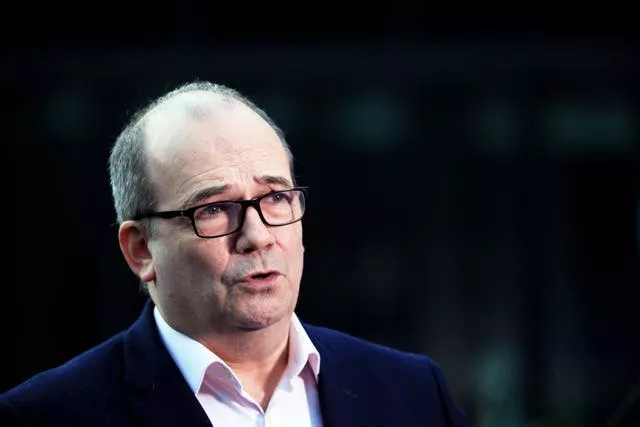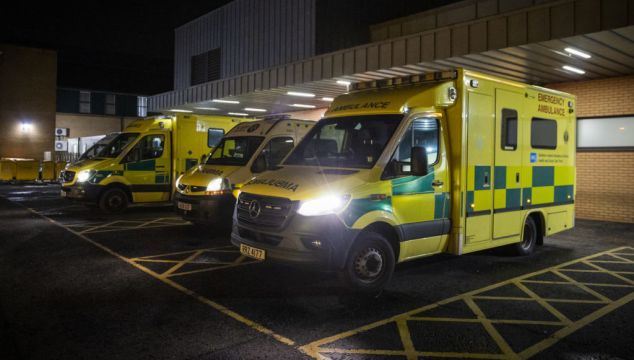A patient waited four-and-a-half days for treatment at an emergency department in a hospital in Northern Ireland, health chiefs have said.
It was also revealed that some non-urgent callers to the ambulance service are waiting up to 24 hours for a response.
Setting out the scale of the crisis facing the health service in Northern Ireland, the North's chief medical officer Sir Michael McBride said he had serious concerns about the ability of the health service to get through the winter.
Earlier this week health trust chief executives set out new measures to tackle hospital pressures, including patients leaving hospital no later than 48 hours after they are medically fit for discharge, where a suitable placement is available.
There will also be a maximum three-hour wait for ambulance handover.
Health staff have been taking part in industrial action over pay, leading to disruption to services and hundreds of medical appointments postponed.
During a media briefing, health chiefs provided statistics to illustrate the pressure facing hospital services.
At 9am on Monday, there were 399 patients in emergency departments across Northern Ireland who had been given a decision to admit but had no bed immediately available.
This is understood to be one of the highest rates ever recorded.
By 9am on Tuesday the number had reduced slightly to 335.
However, there were 542 patients in total in emergency departments waiting for treatment. Of these 447 had been waiting longer than four hours and 300 had been waiting longer than 12 hours.
The longest wait for treatment was recorded at 107 hours, 43 minutes.
At the same time there were 22 ambulances parked outside emergency departments with patients waiting to enter.
The statistics also revealed that at midnight on December 20, 569 patients in hospitals had been declared medically fit to leave but were waiting on care packages.
Health chiefs are concerned that the situation will deteriorate further at the beginning of next year, when there is historically a spike in numbers needing hospital treatment.
Mr McBride said: “As chief medical officer I have very serious concerns about the ability of the health service to get through this winter.
“I cannot recall a time when concerns across the system were at this level.
“Our workforce is exhausted, our health service is still dealing with the many consequences of the pandemic.
“The cumulative impact of industrial action, and the seasonal impacts of flu and Covid, are likely to cause further pressures after the Christmas holidays.
“The health service is extremely fragile and an extraordinary effort by staff has been required for many months up to now.

“We will all need to play our part in supporting our staff to get through the coming weeks.
“We, the public, need to get our flu and Covid-19 vaccines to protect ourselves, others and the health service from potential surges from these viruses.
“If you need urgent help then our health service is here for you, but we do need to use it wisely, and I ask everyone to work with hospital teams to support the discharge of your relatives when their medical care is complete.
“This winter will be about providing the best care we can, minimising harm and supporting staff while yet again they take the strain.”
Michael Bloomfield, chief executive of Northern Ireland Ambulance Service, said: “It has been a particularly busy period, we expect that to continue and indeed to get worse over the next couple of weeks.
“Over the last four weeks we have received on average about 800 999 calls every day. It peaked on Monday of this week at 1,000.
“Our response time to category one calls – that’s the most urgent life-threatening calls – they should receive a response within eight minutes.
“Our average response over the weekend was 14-and-a-half minutes. We had some people waiting up to half-an-hour.
Chief Medical Officer ‘extremely concerned’ at health service pressures and emphasises vital importance of vaccination to help health and social care system get through this winter.
Read➡️https://t.co/3MZylas3K8 pic.twitter.com/f4RJNn0Aq2— Department of Health (@healthdpt) December 21, 2022
“For category two calls, which are still very sick patients, we should respond within 18 minutes.
“On Saturday that peaked at an average of one hour, 32 minutes, with some calls taking up to four hours.
“For the less urgent but still sick patients in category three, we have had some patients waiting as long as 24 hours for a response from an ambulance to arrive.
“We are losing between 25-30% of our operational capacity every day waiting outside emergency departments.
“Most days there are patients waiting in the back of ambulances for up to nine or 10 hours and that is a really poor experience for those patients.”
Responding to reports that a man had died after waiting more than nine hours for an ambulance, Mr Bloomfield expressed condolences to the family.
He added: “Regrettably someone waiting as long as nine hours is not unusual at present. It can be much longer.”
Mr McBride said patients and staff would continue to pay the price if there was not significant investment and reconfiguration of services.
He said: “As ever, sadly, it is those staff working at the front line and the patients taking the strain.”







